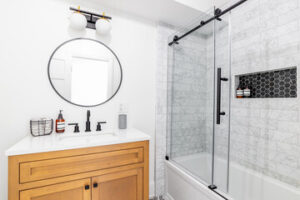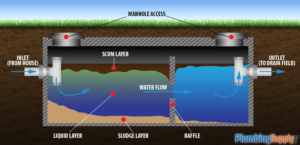Water Damage Repair Los Angeles is a serious problem that can be devastating to your home. It can lead to structural damage, mold, and more. This is why it’s important to take the necessary steps to address the issue.
Start by turning off the water source and electricity. Then, assess the damage and begin repairs.

- Remove the Water
The first step in any water damage repair is to remove the excess water. This is typically done using equipment like wet vacs or pumps. These devices can help remove thousands of gallons of water quickly and effectively. This is a crucial step to prevent secondary damages, such as mold growth and rotting wood.
The next step is to dry and sanitize the area. This process involves using techniques to remove contaminants and protect occupants’ health. Professionals will use specialized drying methods, such as dehumidification and disinfectants, to ensure that the space is safe for reoccupation.
Water damage restoration professionals will also work to save any items that can be saved from further damage. This may include furniture, electronics, documents, and other possessions. They will also utilize special techniques to remove moisture pockets and prevent mold growth.
It’s important to note that the longer a space sits exposed to water, the more damage it will likely cause. This is why it’s essential to call in a water damage restoration expert as soon as possible.
A professional will start the water damage restoration process by conducting a thorough inspection. They will use advanced equipment, such as hygrometers and moisture detectors, to determine how much water is present and what the cause of the problem is. They will also classify the water damage according to its severity. This will allow them to develop a plan for repairing and restoring the space. Water damage can be categorized as Category 1, 2, or 3. Category 1 water is considered clean and is usually from sources like broken pipes. Category 2 water is contaminated and may contain chemicals or soap scum. Finally, category 3 water is extremely dangerous and is often from sewage backups or floodwaters.
- Disinfect the Area
Water damage is one of the most serious property issues you can face. From a burst pipe to flooding, water problems can destroy your home and ruin the belongings inside. It is important to act quickly to mitigate the problem and start repairs. If left unaddressed, a single incident of water damage can lead to major problems, including mold, mildew and compromised framing and foundations.
The first step in water damage repair is to remove the standing water from the affected area. Then, it is important to disinfect the area to prevent any future problems. This includes cleaning the carpets and floors, as well as disinfecting any materials that came into contact with the water. This will help to protect your family’s health and the integrity of your home’s structure.
If you have extensive water damage, it is important to consult a professional for cleaning and disinfection. They can help you decide which items are salvageable and which need to be discarded. They will also use fans and dehumidifiers to speed up the drying process.
For minor water damage, you can try to clean the areas yourself. However, you should always check for signs of a leak. For example, you should look under sinks and appliances for leaking pipes. You should also be on the lookout for any unusual mold or mildew in your house.
You can take some steps to prevent water damage to your home, such as extending downspouts so that the rain falls away from your home. It is also a good idea to install a rain barrel, especially if you live in a wetter area. This will help to reduce the amount of rainwater that comes into your house and minimize the potential for flooding.
- Dry the Area
Once all the water has been extracted and the area disinfected, it is time to begin drying the affected area. Moisture can cause serious damage in only a few hours, so it is important to dry the area as quickly as possible. This can be done by opening windows and using fans to circulate air in the room. You can also rent a large dehumidifier from a hardware store to help draw moisture out of the room.
Ideally, you should wait for the area to be completely dried before moving anything back into it. You should also take any valuables that were exposed to water to a safe place, like another room of your home or a friend’s house until the area is restored. It is also a good idea to remove any rugs and carpets that have been saturated with water. This will allow the floor beneath to dry out more quickly and reduce the chances of permanent damage.
Professional water restoration companies use a variety of equipment to dry the area, including heavy-duty fans (including air movers) and commercial-grade dehumidifiers. They will also open the windows and doors to increase air circulation and speed up the drying process. In addition, they will sanitize any furniture that has been exposed to the water and may remove or clean any contaminated materials, such as documents or photographs.
If you have a lot of water damage to deal with, it is best to contact a professional water restoration company right away. They will have the tools, machinery, and expertise to handle all of the steps involved in restoring your home or business. They will also be able to give you an accurate estimate of how long the work will take.
- Replace the Damaged Materials
When water gets into your home, it can cause serious damage if left unaddressed. Luckily, you can often repair some of the damage yourself. However, it’s important to know when to call in a professional.
The first thing you need to do is check the condition of your home before you begin the water damage restoration process. This will help you decide how much work is needed. You’ll want to make sure that the area is safe to enter, including making sure that all electrical outlets have been turned off. You should also take the time to wear protective clothing and eyewear to avoid getting irritated by any contaminants that may be present in the water.
Once you have removed any dangerous materials, it’s time to start cleaning and disinfecting the affected areas. You’ll want to disinfect any porous surfaces, including carpet, fabric, and insulation. These items will quickly develop mildew and mold if not properly cleaned and dried. You’ll also want to disinfect any wood that has been soaked up. Using a disinfecting solution will ensure that any mildew and mold is killed before you begin working on the reconstruction of your home.
It’s important to replace any materials that have been severely warped, rotted or damaged by water. You should also replace any wood that has developed mold/mildew problems. If the wood is a structural component of your home, you’ll need to carefully remove it so that you can properly repair and replace it. If the wood isn’t a structural part of your home, you can simply saw out the affected boards and replace them with new ones. Remember, however, that the longer that the wood remains wet, the more it will affect your home’s structure.
- Restore Your Property
After the water has been removed and everything is cleaned, it’s time to restore your property. This includes repairing any damage caused by the water, replacing materials that were permanently damaged, and relocating items. This can be the most time-consuming part of the entire process, as many possessions need to be replaced and some construction may be necessary (in the case of serious water damage).
One important thing to keep in mind when restoring your property is that it’s best to do so as quickly as possible. The longer moisture remains in a building, the more it will affect the structure of the property and lead to issues like mold and mildew growth and worsened structural damage. This is why it’s so crucial to contact a professional restoration company as soon as you notice any water damage.
When selecting a restoration company, it’s a good idea to ask them about their process and what you can expect during the cleanup and repair process. Also, find out whether they are certified by the Institute of Inspection, Cleaning and Restoration Certification (IICRC) and if they offer insurance to their clients during the restoration process.
In addition, it’s a good idea to take pictures of all the areas affected by the water damage before beginning the clean-up. This will help you and the restoration company identify all the items that were damaged by the water and will make it easier for the insurance adjuster to review the claim. It’s also a good idea to document the value of all items that were lost in the water damage so you can get them replaced under your insurance policy.

